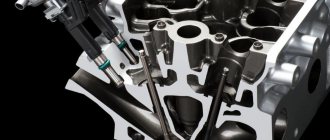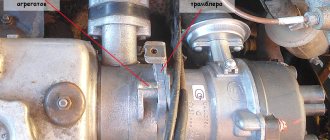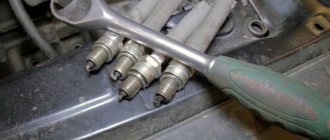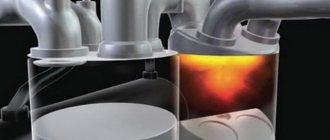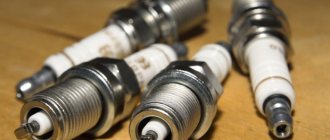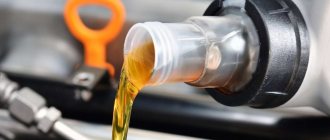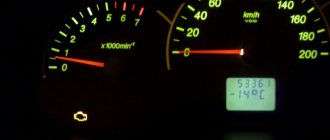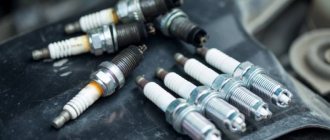List of possible causes of power loss
Not every driver, even an experienced one, can quickly answer the question: why the thrust of the VAZ 2114 engine with 8 valves disappeared the first time.
To do this, you need to consider all possible sources of failure:
- debris entering the gasoline filter;
- clogged fuel pump diaphragm;
- malfunction of the sensor that controls air flow;
- poor spark plug performance;
- malfunction of the ECU (electronic engine control unit);
- dusty air filter;
- clogged injectors;
- complete wear of the clutch disc;
- insufficient compression in the cylinders.
Analysis of the causes of poor engine traction and possible repairs
Fuel filter dirty
This may be due to low-quality gasoline (containing various small debris) or infrequent cleaning of the fuel tank. In this case, you will have to completely replace the entire filter system.
Fuel pump diaphragm clogged
The cause of the blockage, as a rule, is low-quality gasoline. To clean it, just remove the diaphragm and rinse it thoroughly or blow it with air.
Malfunction of the sensor that controls air flow
This is the most common reason why the VAZ 2114 does not work.
- Engine idle speed is too high or low;
- intermittent engine idling;
- disturbed acceleration dynamics. The car becomes uncontrollable and often freezes.
It is worth periodically checking the operating condition of the air flow meter to avoid wasting time and money diagnosing the engine.
Air filter dust
The more the filter is clogged with dust, the less air flows to the engine, therefore, the thrust decreases. What can be done in this case? Ideally, the filter should be replaced with a new one, but if this is not possible, you should remove the filter, tap and blow to remove large debris (flies, dry leaves, insects).
Clogged injectors
If the injector nozzles are clogged, you will have to go to a service station for ultrasonic cleaning, or purchase a special cleaning liquid.
Auto mechanics advise purchasing only high-quality injector cleaning products, for example, Wynn's (Vince), LIQUI MOLY, Carbon Clean.
The procedure itself is quite simple: the cleaning agent needs to be poured into the gas tank. But this method can only help if the fuel system is not very dirty. An engine with several hundred thousand kilometers will most likely need a complete replacement of injectors.
Complete wear of the clutch disc
You can determine disk wear by the following signs:
- the pedal is easily “recessed”, but does not return;
- the clutch slips;
- when the clutch is engaged, a noticeable vibration occurs;
- it is impossible to disengage the clutch.
There is another way to check wear: if you try to move off in fourth gear and the engine stalls, then there are no problems with the disc. If the engine continues to run, then the clutch disc will probably have to be replaced.
Poor spark plug performance
There are several signs by which you can identify a faulty spark plug:
- at idle the engine makes an unpleasant noise;
- a sharp press on the gas causes power failures;
- the engine runs unevenly;
- increased fuel consumption with reduced power;
- the spark plugs are filled with gasoline.
Visual inspection of the spark plugs can also help identify the problem. If the candle is covered with dark oil, has a gloss or velvety soot, then this clearly indicates problems.
Defective spark plugs must be replaced with new ones.
Insufficient compression in cylinders
This defect appears due to high wear of the entire cylinder-piston system. As a result, the car owner notices that oil consumption increases, the combustible mixture does not burn completely, and fuel enters the crankcase. This problem is serious and can be solved either by replacing the piston rings or by completely repairing the engine at a service station.
Malfunction of the electronic engine control unit (ECU)
There may be several signs of an ECU malfunction:
- various mechanical damages on it;
- lack of indicators from various sensors monitoring systems;
- absence of control signals for the fuel pump, vehicle idle system and other mechanisms controlled by the ECU.
Unfortunately, this device cannot be repaired in most cases. Even service station specialists will offer to simply replace the ECU with a new one after carrying out diagnostics.
Why the VAZ-2114 engine pulls poorly: the main reasons and repairs
VAZ-2114 cars, from the start of production, are equipped with eight-valve engines with a volume of 1.5 liters. Since 2007, they have been equipped with an eight-valve 1.6 liter engine with an environmental class of Euro-4. The operation of the car, sometimes incorrectly, brings “surprises” over time. The engine does not perform its functions at full power, and thrust decreases. Let's try to understand the causes and methods of elimination.
conclusions
Maintenance, which should be carried out according to the manufacturer’s recommendations, will avoid many problems. The only question is where to go, at the “Kulibins”, or at specialized service stations equipped with the necessary equipment and equipment. The choice is up to the vehicle owner. The sooner the prerequisites for the failure of a particular part are identified, the less financial losses there will be in the future . It should be remembered that timely maintenance increases the safe operation of the vehicle.
Source
Visiting a car service center
In a situation where you specifically do not have enough experience in car maintenance, there is a fairly high probability of aggravating the problem by unqualified intervention in the operation of various on-board systems.
It is important to objectively assess your own capabilities, and if you don’t have faith in yourself, then it is better to entrust the repairs to specialists. In a situation where it turns out that the problem is not particularly serious, they will not take much money from you. But in any case, you will be able to avoid many of the troubles associated with unqualified attempts to repair the vehicle.
Sources
- ladaautos.ru/vaz-2114/pochemu-vaz-2114-gloxnet-pri-sbrose-gaza.html
- vaz-2114.info/vaz-2114-inzhektor-glohnet-na-holostyh/
- remontvazov.com/padayut-oboroty-posle-sbrosa-gaza-na-vaz-2114
Why the VAZ-2114 engine pulls poorly: the main reasons and repairs
At the same time, in many cases the engine runs smoothly, does not tremble, there are no increased vibrations, extraneous sounds, knocking or noise during operation of the internal combustion engine. Let us note right away that there is a fairly wide list of possible reasons why a warm engine does not run, and there is a loss of engine power when cold and/or when hot.
In this article we will talk about why the engine does not pull, and also consider the most common malfunctions that manifest themselves in the form of loss of traction of the power unit.
The engine does not pull and the traction is lost - what to do?
Probably, any driver has encountered such a problem when the car has lost its former dynamics: it takes a long time to accelerate, and when climbing, it completely refuses to move in higher gears. In this article we will tell you in detail what to do if the VAZ engine does not pull or pulls poorly, we will look at the main causes and troubleshooting methods.
Conventionally, all types of gasoline engines can be divided into gasoline and injection. In general, their principle of operation is absolutely the same, but the factors that affect engine power become different. Let's consider the problem of carburetor and injection engines separately.
The engine does not pull: the main reasons for the decrease in engine power
So, if no other symptoms other than loss of traction are detected, then you immediately need to pay attention to the quality of the fuel, the proper functioning of the ignition and power systems.
- As practice shows, more than half of the cases of reduced efficiency from internal combustion engines are associated with fuel. The engine does not turn on due to the fact that the tank may be filled with low-quality or unsuitable fuel for this type of engine (for example, 92-grade gasoline instead of 95-grade gasoline).
In some cases, after refueling, problems may also arise with starting the engine, and engine detonation may occur. To solve this problem, it is often enough to dilute the existing fuel with a higher quality one. Less often, it becomes necessary to completely drain the fuel from the tank, after which additional flushing of the power system is performed.
Typically, such manipulations are necessary when, parallel to the loss of traction, unstable operation of the internal combustion engine is noted, the speed jumps or floats at idle and under load, the engine does not start easily, the “check” light is on the panel, etc.
Also, owners of gasoline engines can independently determine the quality of gasoline by the spark plugs and their appearance. To check the spark plugs you need to unscrew them from the engine. A disruption in the combustion process of the fuel-air mixture in the cylinders, as well as the presence of impurities in the fuel, can be identified by soot on the spark plugs and its color.
For example, if the fuel contains a lot of third-party metal-containing additives and additives, then the skirt and electrodes may become covered with reddish soot (brick-colored). Black soot will indicate that the fuel is not burning properly, etc. In any case, malfunctions in the combustion process of the working mixture lead to the fact that the engine stops pulling.
- The next step in diagnosis is checking the spark plugs. A decrease in the efficiency of these elements is also accompanied by a decrease in the power of the power unit.
This is especially noticeable during sharp accelerations, and when the car is already moving at high speed. In other words, the motor has no “reserve” left for further acceleration.
The candles may be dirty, and it is also possible that their life has come to an end. To fix this problem, you can clean the spark plugs or immediately replace the entire set with a new one.
It is important to take into account that if new spark plugs are correctly selected for a specific engine in terms of heat rating and other parameters, but still quickly become dirty, then the reason for the loss of traction is not in them. The formation of carbon deposits in this case indicates problems with mixture formation or combustion of the fuel charge in the cylinders.
- If everything is in order with the spark plugs, then you need to check the condition of the fuel and air filters. In the first case, insufficient throughput can lead to the fact that the required amount of fuel is not supplied to the cylinders to prepare the so-called “power” mixture.
As a result, the engine loses power, that is, it does not pull under load. In such a situation, it is enough to replace the specified filter element. As for the air filter, the problem is similar to the fuel filter, but in this case there is a lack of air in the fuel-air mixture.
This leads to the fact that fuel without a sufficient amount of oxygen burns incompletely. In such conditions, engine power naturally drops, carbon deposits form in the combustion chamber, spark plugs become increasingly dirty, etc. To solve the problem, the engine air filter also needs to be replaced.
VAZ injection engines
In injection engines VAZ-2110, 2112, 2114, 2115, both 8-valve and with a timing belt with 16 valves, it is more difficult to identify the cause of the decrease in power due to the more complex design of the main systems.
Supply system
Any injector consists of a mechanical executive part and an electronic control part, and problems can arise in both of them, which will lead to a drop in power.
Let's look at the mechanical part first. Here, cravings can be influenced by:
In general, almost every element of the injector executive part can be the culprit for a decrease in dynamics.
The situation is approximately the same in the electronic component.
The operation of the engine with the injector is controlled by an electronic unit, which constantly monitors the parameters through sensors installed on different systems.
The number of these tracking elements is considerable and the breakdown of any of them leads to the fact that the ECU incorrectly evaluates the indicators on the basis of which it controls the executive part.
Thus, the lambda probe, DPKV, mass air flow sensor, DPZ, phase sensors, detonation sensors and coolant temperature sensors in the event of a breakdown lead to a decrease in power, so you will have to check all of them in search of the cause.
Ignition and exhaust system
As for the ignition system of injection engines VAZ-2110, 2112 and others, the reasons may be:
Another possible cause could be a misalignment of the generator drive pulley (with the ring gear).
Because of this, the DPKV readings are disrupted, as a result the operation of the ignition system is disrupted, which leads to a drop in traction.
In injection engines, the exhaust gas removal system more often creates this problem than in a carburetor car, and all due to the use of a catalyst.
The element's honeycombs have a small cross-section, so they become clogged quite quickly, which leads to exhaust gases “crushing” the engine.
Malfunctions of the power supply system, ignition and impaired mixture formation
While problems with spark plugs and filters can be identified on the road, more serious problems associated with the power and ignition system are much more difficult to diagnose and fix on site. In cases where the engine does not pick up speed, and jerks and dips are noted when pressing the gas pedal, it is necessary to check and adjust the carburetor or injector.
Let's focus on the more common electronic injection. The list of main malfunctions of modern injection internal combustion engines includes:
- malfunctions, decreased performance or contamination of the fuel pump mesh filter;
- malfunction of injection nozzles;
- problems with ECM or ECU sensors;
- ignition system malfunctions;
- air leaks and leaking fuel lines;
If we talk about the ignition system, in addition to the spark plugs, you should also check the OZ, high-voltage wires, ignition coils, etc. As for the fuel supply, at the initial stage you should measure the pressure in the fuel rail (rail). At the same time, the pressure regulator in the fuel rail is also checked.
Often, on many cars, problems are associated with the fuel pump, which is located in the gas tank, as well as with the specified regulator. To measure fuel pressure, a pressure gauge is connected to the rail; the obtained values are compared with those recommended for a particular engine. If the pressure is below normal, then the culprit may be either the fuel pump or the pressure regulator.
The regulator's task is to discharge excess fuel into the return line at a time when the pressure is higher than normal. If the settings are incorrect or the regulator itself is leaking or faulty, then the fuel will be discharged into the return line ahead of time. To check this, air is pumped in with a compressor or pump, and the pressure in the rail increases. If the regulator operates earlier than the recommended pressure, the element must be adjusted or replaced.
We also recommend reading the article about why the engine jerks during acceleration. From this article you will learn about the main causes of engine jerking when you press the gas sharply, as well as ways to identify this problem and repair it.
If the gas pump does not pump gasoline or the required pressure is not created, it is necessary to remove the device from the tank, clean or replace the mesh on the pump. If the situation does not change, then the pump is faulty and needs to be repaired/replaced.
As for injection nozzles, these elements must not only open and close in a timely manner, but also supply fuel to the cylinders in full. The shape of the spray pattern is also important. For this reason, the injectors must be checked and cleaned regularly to ensure that the fuel is sprayed evenly.
- ECM sensors (mass air flow sensor, air pressure sensor, etc.) send a signal to the ECU, thanks to which the controller takes into account how much air the engine consumes. Based on these data, the unit determines how much fuel needs to be supplied through the injectors to form the required fuel-air mixture, taking into account a particular operating mode of the internal combustion engine.
If the sensors do not work correctly, the ECU may supply the wrong amount of fuel. As a result, the engine does not pull and the car does not drive as it should. You can use a multimeter to check the sensors, but the best way is to conduct computer diagnostics of the engine.
Power drop on a VAZ carburetor engine
To begin with, let's take VAZ cars with a carburetor power system and an 8-valve timing system - VAZ-2109, VAZ-2110, VAZ-2114, VAZ-2115.
The same power plant is installed on these cars, so the reasons are identical.
Let's go through those components, due to malfunction of which a drop in dynamics may occur.
In general, the main reason that the engine does not pull is a change in the processes in the combustion chambers - a mismatch in the proportions of the air-fuel mixture, the combustion process is disrupted, the filling of the cylinders and the removal of exhaust gases does not occur as required.
Supply system
Very often, a drop in traction occurs due to the power system. Structurally, the carburetor fuel system used on cars from VAZ-2109 to VAZ-2115 is very simple and is almost completely mechanical, so identifying the cause is not particularly difficult.
A decrease in power can occur due to:
- Severely clogged fuel filter (its throughput drops and the pump is simply not able to pump the required amount of fuel);
- Contamination of the carburetor channels (the jets and fuel channels in this element have a small cross-section and debris often clogs them);
- There is air leakage in the area from the tank to the pump (because of this, the performance of the fuel pump drops sharply);
- Damage to the fuel pump membrane (a small crack in it leads to the fact that the vacuum required for pumping fuel is not created in the pump chambers);
- The fastening of the carburetor or intake manifold is loose (due to this, air leaks around the carburetor and the proportion of the air-fuel mixture is greatly disturbed);
- The hole in the fuel tank cap is clogged (because of this, a vacuum is created in the tank and it is much more difficult for the gas pump to pump gasoline out of it);
In addition to the elements responsible for supplying fuel, a drop in power also occurs due to severe contamination of the air filter element.
Ignition system
This system also takes part in the combustion of the mixture, which means a failure in its operation can affect power.
In carburetor engines VAZ-2110 and others, a decrease in traction can occur due to:
- Faulty spark plugs or changes in their thermal gap;
- Excessive wear of the contacts and the central electrode of the distributor;
- Voltage losses in high-voltage wires;
- Violations of the ignition timing.
Irregularities in the power supply and ignition systems most often cause a drop in power, so testing to identify the cause should begin with them.
If the operation of these systems does not raise suspicions, other components of the engine should be diagnosed.
Exhaust system, timing belt and crankshaft
Loss of traction can also occur due to the exhaust gas removal system, although problems with it rarely occur on carburetor engines.
The main reason here is the reduction in throughput due to large deposits in the muffler. Because of this, exhaust gases, without having time to escape from the cylinders, “choke” the engine.
The reasons for the drop in thrust are also often the gas distribution mechanism and the cylinder-piston group.
Here the reduction in power occurs due to:
- Violations of the thermal clearance of valves.
- Heavy carbon deposits on the valve plates and seats, or their burning.
- Occurrence of rings.
- Limit wear of the CPG.
- Cylinder head gasket failure.
conclusions
Maintenance, which should be carried out according to the manufacturer’s recommendations, will avoid many problems. The only question is where to go, at the “Kulibins”, or at specialized service stations equipped with the necessary equipment and equipment. The choice is up to the vehicle owner. The sooner the prerequisites for the failure of a particular part are identified, the less financial losses there will be in the future . It should be remembered that timely maintenance increases the safe operation of the vehicle.
As a rule, during the long-term operation of a vehicle, almost every driver sooner or later notices that the engine does not pull well. In other words, the power unit has difficulty coping with the loads, there is a loss of power, the unit needs to be cranked up to high speeds to maintain the usual pace, the car accelerates worse from a standstill, picks up speed slowly, etc.
At the same time, in many cases the engine runs smoothly, does not tremble, there are no increased vibrations, extraneous sounds, knocking or noise during operation of the internal combustion engine. Let us note right away that there is a fairly wide list of possible reasons why a warm engine does not run, and there is a loss of engine power when cold and/or when hot.
VAZ 2114 loses traction while driving
everything is ok, the watch))) The check light came on ((I waved the old high-voltage wires, threw off the terminal, smoked a lot, thought a lot, put it on, started it and everything was back to normal, happy, went home to wash, fix the passenger handle, change the light bulbs in the PTF, such a weekend For the money, dpdz250, dxx740, fuel pump 1200, rubber filter, mesh 250)) Smooth roads and full tanks to everyone!
Hello. While driving, the gas pedal traction disappears, in any driving mode. It feels as if I just took my foot off the pedal, but it’s there and if you press the floor, there’s 0 attention. And if you keep it this way until it stops, then after 10-15 seconds it returns to normal. Or release the pedal and immediately press it, then it starts driving, 2011, with an electric pedal
Check the opening angle (operating parameters) of the damper and the angle of the gas pedal using a diagnostic scanner at the time of the malfunction, also check the throttle valve and gas pedal connector.
I also came across this option at a VAZ. The malfunction appears from time to time, but... there are no errors. After some checks and tests, it turned out that the mass air flow sensor was “dying”, it was replaced and the “glitches” were gone. There you need to measure the voltage on the signal wire (from 0.99V to 1.02V - the sensor is working, 1.03V - its service life is ending and there may be temporary fluctuations, if the readings are higher, then it is practically no longer suitable for work). measurements with the ignition on. There is a simpler way: turn off the DPKV and do a test run; If the situation improves, the sensor will be replaced.
Subscribe
to our channel in
Index.Zen
Even more useful tips in a convenient format
Where are the masses of the VAZ 2114?
The starter does not work on a VAZ 2115
What is the normal charging voltage for a VAZ 2115 battery?
As a rule, during the long-term operation of a vehicle, almost every driver sooner or later notices that the engine does not pull well. In other words, the power unit has difficulty coping with the loads, there is a loss of power, the unit needs to be cranked up to high speeds to maintain the usual pace, the car accelerates worse from a standstill, picks up speed slowly, etc.
At the same time, in many cases the engine runs smoothly, does not tremble, there are no increased vibrations, extraneous sounds, knocking or noise during operation of the internal combustion engine. Let us note right away that there is a fairly wide list of possible reasons why a warm engine does not run, and there is a loss of engine power when cold and/or when hot.
In this article we will talk about why the engine does not pull, and also consider the most common malfunctions that manifest themselves in the form of loss of traction of the power unit.
Read in this article
Do-it-yourself troubleshooting
It is possible to eliminate power failures on your own only when the reasons that caused the failures can be easily eliminated even by a novice car enthusiast.
- If it turns out that the car has spark plugs with the wrong heat rating, then it is quite possible to buy and install new spark plugs, having first specified the correct heat rating in the instructions.
- If the gaps between the spark plug electrodes are clogged and so-called jumpers have formed on them, then they can be completely eliminated with a piece of coarse sandpaper.
- You can also inspect and, if necessary, replace damaged high-voltage wires yourself.
- Cleaning the fuel filter mesh is also not difficult in most cases. As a rule, to do this, it is enough to unscrew several screws that hold the filter cover on.
- You can also replace a clogged air filter yourself. But before going to a car store, you should still look at the machine’s operating instructions to clarify the parameters and brand of filter.
In all other situations, you cannot do without the help of a qualified mechanic. The car will have to be taken to a car service center, since a novice car enthusiast will do more harm than good with his actions.
The worst thing about power dips is that they can be caused by a huge number of reasons. And identifying the real cause of failures can take a lot of time, much longer than the repair itself. Therefore, the most reasonable solution is to entrust the search for reasons to professionals. They not only have the necessary experience, but also a lot of special equipment. The only exceptions can be the cases mentioned above, when the cause of the problem lies on the surface.
Poor vehicle performance caused by loss of engine power can have several causes. Sometimes these problems can be solved with minor repairs, so be sure to check the vehicle's basic components first.
In this article we will talk about the 7 most common reasons for loss of engine power, which will help you deal with your problem much faster.
Checking the transmission
Sometimes the power unit can develop serious power, but it does not reach the wheels. If while driving you hear that the engine is working hard, but you don’t feel speed, then perhaps the automatic transmission system is slipping or there are blockages on the brakes.
To check, you need to drive onto a straight section, set the automatic transmission selector to position D, and then see how the car behaves. If the speed decreases, then the brake system should be diagnosed. If everything is fine with the brakes, you need to go to a good service station and check the automatic transmission.
You can also check the parking brake. To do this, you need to go to free space. Warm up the car and then pull the handbrake. Next, press the brake pedal and set the gearbox selector to position D. Next, press the accelerator. If the engine keeps the rpm around 2000, then everything is fine with it. If it is less or more, you should go to a service station to test the automatic transmission.
On diesel
Some of the reasons for power loss listed above are also relevant for diesel engines. But there are also a number of specific points associated with diesel engines that should be mentioned. One of the most common causes of power loss in a diesel engine is the failure of the turbocharger. When this unit fails, it usually begins to emit a characteristic whistle, which is difficult to confuse with something else. But in order to accurately determine the breakdown, you will have to send the car to a car service center. There they will scan it and identify the problem. Why might the turbo turn off? Here are some options.
- The charge air pressure sensor has failed.
- The turbine has simply exhausted its factory life.
- The tightness of the joint between the compressor and the motor is broken.
- The air path is clogged.
- The turbocharger axis has become coked, causing its rotation to slow down.
- The turbocharger shut-off valve has failed.
A characteristic external sign of a compressor failure is blue smoke coming out of the exhaust pipe.
It occurs due to the combustion of oil, the excess of which enters the combustion chambers of the cylinders due to leaks in the compressor. If the tightness of the compressor discharge line is broken, air leaks occur and the mixture becomes too rich. When it burns, not blue smoke comes out of the chimney, but black smoke. Finally, white smoke indicates that the oil line through which oil is drained from the compressor is clogged.
If the diesel engine doesn't work
A decrease in traction can also occur in diesel engines. If we look at old cars that have completely mechanical power systems, then the most common cause is depressurization of the system.
As a result, air enters the fuel, which is why the fuel injection pump is unable to provide the required pressure.
Don't forget about:
And if we also add possible problems with the timing belt and CPG, then identifying the cause will not be so easy.
In modern diesel installations, where an additional electronic component is used, the search range will increase.
For example, the Common Rail system uses all the same sensors as the injection engine. And if at least one of them breaks, this will certainly affect the operation of the control part.
Malfunction of the gas distribution mechanism
Breakdowns or incorrect adjustment of the gas distribution mechanism shifts the gas distribution phases from the optimal point and causes a sharp decrease in engine power. This occurs due to incomplete release of exhaust gases from the cylinders, or insufficient filling with air or the air-fuel mixture. If the timing chain or belt jumps one or more teeth, it disrupts the operation and adjustment of the mechanism that provides the required ignition timing depending on engine speed. A significant drop in power is also observed when the timing valves are incorrectly adjusted, when they are insufficiently opened or not completely closed.
Other reasons
Finally, we note that some reasons are very rare and can be considered specific.
These include loosening the exhaust manifold, although initially it may seem that this cannot affect the engine.
In fact, on many cars, heat from the manifold is used to warm up the air entering the cylinders, and for this purpose a special screen is used, to which the air duct fits.
So, if a breakdown occurs and the exhaust gases break out, then most of them will enter the cylinders again through the air duct, and due to a lack of air, the power will decrease.
Also, the reason may lie not in the engine, but in the transmission elements, especially for cars equipped with automatic transmission.
Malfunctions in the box lead to the creation of excessive load on the engine, which will be perceived as a loss of power.
OUR SITE RECOMMENDS:
The vertical scanning chip is heating up
15.12.20190
07/22/2014, 02:20: Ars 07/22/2014, 07:41: musor micra piping...
Bernie ecclestone formula 1
15.12.20190
Contents1 Contents2 Biography 2.1 Early years 2.2 Owner...
Harmful effects of computers on human health
15.12.20190
Contents1 Contents2 Negative factors of the influence of a computer on a person3 ...
Drivers for Alcatel Pixie 4
15.12.20190
Contents1 How to install the driver1.1 Description2 Popular Alcatel smartphones3 …
The last notes
How to recover Instagram page without email
15.12.2019 0
How to restore a VK page without a last name
15.12.2019 0
How to restore a VK page if the number is lost
15.12.2019 0
How to restore a column in Excel
15.12.2019 0
Solving the problem of deteriorating vehicle traction
ZMZ-409 engineZMZ 409 engine In any case, the problem of a drop in vehicle power cannot be ignored. Having made itself felt today, it will progress every day and cause more and more inconvenience and will ultimately damage the engine. Timely computer diagnostics and a thorough inspection of the machine by a qualified specialist will help you get rid of the problem.
Replacing spark plugs, high-voltage wires, and an air filter can, of course, be done on your own if the need arises. But if, after installing new parts, the behavior of your personal vehicle has not changed for the better, it is worth sending it for diagnostics to a specialized service, where experienced technicians will diagnose the cause of the deterioration in traction of your car.
Source

